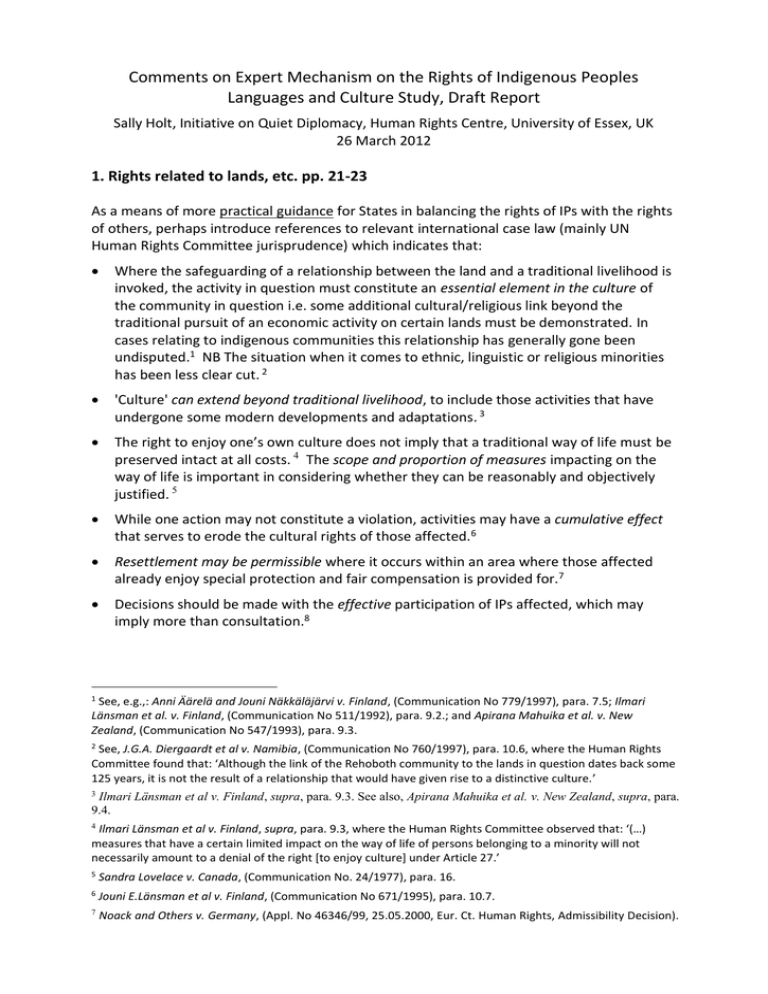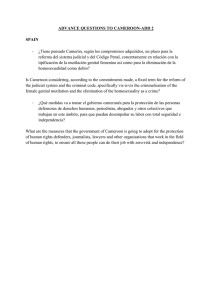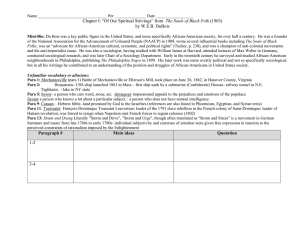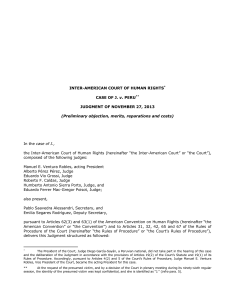Comments on Expert Mechanism on the Rights of Indigenous Peoples
advertisement

Comments on Expert Mechanism on the Rights of Indigenous Peoples Languages and Culture Study, Draft Report Sally Holt, Initiative on Quiet Diplomacy, Human Rights Centre, University of Essex, UK 26 March 2012 1. Rights related to lands, etc. pp. 21-23 As a means of more practical guidance for States in balancing the rights of IPs with the rights of others, perhaps introduce references to relevant international case law (mainly UN Human Rights Committee jurisprudence) which indicates that: Where the safeguarding of a relationship between the land and a traditional livelihood is invoked, the activity in question must constitute an essential element in the culture of the community in question i.e. some additional cultural/religious link beyond the traditional pursuit of an economic activity on certain lands must be demonstrated. In cases relating to indigenous communities this relationship has generally gone been undisputed.1 NB The situation when it comes to ethnic, linguistic or religious minorities has been less clear cut. 2 'Culture' can extend beyond traditional livelihood, to include those activities that have undergone some modern developments and adaptations. 3 The right to enjoy one’s own culture does not imply that a traditional way of life must be preserved intact at all costs. 4 The scope and proportion of measures impacting on the way of life is important in considering whether they can be reasonably and objectively justified. 5 While one action may not constitute a violation, activities may have a cumulative effect that serves to erode the cultural rights of those affected.6 Resettlement may be permissible where it occurs within an area where those affected already enjoy special protection and fair compensation is provided for.7 Decisions should be made with the effective participation of IPs affected, which may imply more than consultation.8 1 See, e.g.,: Anni Äärelä and Jouni Näkkäläjärvi v. Finland, (Communication No 779/1997), para. 7.5; Ilmari Länsman et al. v. Finland, (Communication No 511/1992), para. 9.2.; and Apirana Mahuika et al. v. New Zealand, (Communication No 547/1993), para. 9.3. 2 See, J.G.A. Diergaardt et al v. Namibia, (Communication No 760/1997), para. 10.6, where the Human Rights Committee found that: ‘Although the link of the Rehoboth community to the lands in question dates back some 125 years, it is not the result of a relationship that would have given rise to a distinctive culture.’ 3 Ilmari Länsman et al v. Finland, supra, para. 9.3. See also, Apirana Mahuika et al. v. New Zealand, supra, para. 9.4. 4 Ilmari Länsman et al v. Finland, supra, para. 9.3, where the Human Rights Committee observed that: ‘(…) measures that have a certain limited impact on the way of life of persons belonging to a minority will not necessarily amount to a denial of the right [to enjoy culture] under Article 27.’ 5 Sandra Lovelace v. Canada, (Communication No. 24/1977), para. 16. 6 Jouni E.Länsman et al v. Finland, (Communication No 671/1995), para. 10.7. 7 Noack and Others v. Germany, (Appl. No 46346/99, 25.05.2000, Eur. Ct. Human Rights, Admissibility Decision). It might also be helpful to discuss (lack of) access to justice and dispute resolution mechanisms, including in cases of historical injustices where land has been taken (or access restricted) with resulting negative impacts on culture. The need for fair and transparent participatory processes should be emphasised. NB One example of positive practice is Mozambique where land use planning takes place on the basis of negotiation with traditional inhabitants and concessions are only granted when consensus reached. You might also note that training/support may be required to support effective representation and informed consent. 2. Equality section pp. 46-47 I would suggest to remove the reference to ‘multi-culturalism’ (as a contentious term from political science discourse with multiple interpretations) and set out the standards very clearly with regard to non-discrimination and equality, distinguishing between: (a) Temporary special measures (under ICERD Arts. 1 (4) and 2 (2); and CEDAW Art 4.) to address discrimination and ensure full and equal enjoyment of human rights and fundamental freedoms; and (b) Measures to protect identity which may not by nature be time limited in the same way since their purpose is to ensure the survival and continued development of cultural, religious of linguistic identity (see HRC GC 23 on Art. 27, para. 6.2 regarding minorities). The wording of the last sentence might be amended to follow more closely the language of the CERD Committee’s Gen Rev 32, paras 14-15 on this point. 8 Anni Äärelä and Jouni Näkkäläjärvi v. Finland, (Communication No 779/1997), para. 7.6, where the Committee noted that the authors and other key stakeholder groups were consulted in the evolution of the logging plans in question and that the plans were partially altered in response to criticisms from those quarters.






